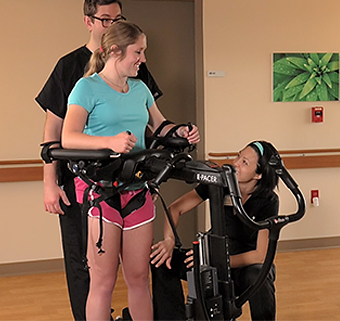Walking with the E-Pacer
Watch: E-Pacer Introduction and Standing with the E-Pacer.
Most patients with severe hemiplegia have difficulty moving or advancing the affected limb during swing phase, as well as difficulty bearing weight during stance phase.
Because the arm on the weak side is usually affected as well as the leg, patients often lack the grip necessary to use a walker for support.
With the Rifton E-Pacer, a rolling stool, a knee brace, and a strap known as a Husky Hang-All, which contains a carabiner, a patient can overcome these obstacles and begin walking much sooner.
The Husky Hang-All facilitates dorsiflexion, knee flexion, and hip flexion on the weak side during swing phase.
The therapist pulls back on the knee brace to facilitate knee extension during stance phase.
If a patient has the ability to stand but not to walk, have them stand from their wheelchair while an assistant places the pelvic support on the wheelchair.
At this point, it is best to move to a quiet hallway that is clear of obstacles.
Make sure that the patient is wearing sturdy shoes with laces or Velcro straps.
Stand the patient up, as shown in the previous video.
Clip the carabiner of the Husky Hang-All to the patient’s shoelaces on the affected side.
Apply the knee brace on the affected side.
An assistant should advance the E-Pacer by walking backwards.
The therapist sits on a rolling stool on the patient’s affected side and puts her feet up onto the side of the E-Pacer.
The assistant pulls the E-Pacer and the therapist along. This allows the therapist to focus on facilitation.
During swing phase, the therapist can assist hip flexion, knee flexion, and ankle dorsiflexion by using the Husky Hang-All to advance the leg forward.
During stance phase, it may be helpful to pull back on the knee brace to extend the knee and prevent buckling.
If there is excessive plantar flexion, whether from extensor tone or flaccidity, it may be helpful to use an AFO in conjunction with the therapist assist.
Bioness functional e-stim can also be very effective in conjunction with the E-Pacer.
As a patient fatigues, his posture may become more flexed and foot drag may increase.
When this is noted, lock the front brakes, and have the patient take a standing rest break.
Facilitate knee, hip, and trunk extension during rest breaks, encouraging the patient to stand tall and stretch.
As a patient progresses, trial gait without the knee brace or Husky Hang-All.
Decrease body weight support as tolerated by lowering the body support slightly.
Once a patient is able to ambulate easily in the Rifton E-Pacer, advancing her own weaker leg without assistance from the therapist or Theraband, she may be ready to switch to gait at the hemi-bar or with a hemi-walker.




